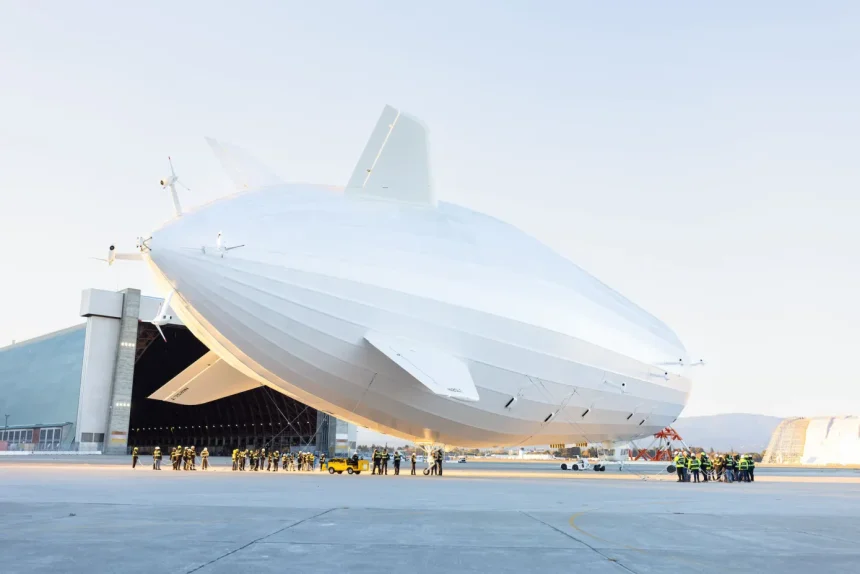Silicon Valley, the hub of technological innovation, recently unveiled the world’s first electric airship prototype, Pathfinder 1. This groundbreaking creation by LTA Research serves dual purposes: supporting Google co-founder Sergey Brin’s humanitarian endeavors and revolutionizing eco-friendly air travel.
Pathfinder 1, designed in a steampunk style, represents the fusion of drone and airship technologies. LTA Research has crafted an airship larger than three Boeing 737s, driven by electric motors and equipped with lidar sensing and fly-by-wire controls for transporting substantial cargo over vast distances.
Before reaching its final destination in Akron, Ohio, where a larger airship, Pathfinder 3, will be built, Pathfinder 1 must undergo a series of challenging flights. LTA Research envisions a future with a fleet of airships serving both emergency response and carbon-free passenger transport purposes.
Pathfinder 1’s Scale
In comparison to colossal aircraft like the Stratolaunch plane, used for launching rockets into orbit, Pathfinder 1’s size is truly awe-inspiring. Stretching 124.5 meters in length, it ranks as the longest aircraft since the Hindenburg airship of the 1930s. However, Pathfinder 1 incorporates modern materials and advanced technology, setting it apart from its ill-fated predecessor.
Unlike its forerunner, Pathfinder 1 opts for helium instead of hydrogen, a far more stable lifting gas. Thirteen exceptionally large rip-stop nylon cells, under the guidance of state-of-the-art lidar laser systems, hold the helium. A robust framework, comprised of 10,000 carbon-fiber reinforced tubes and 3,000 titanium hubs, safeguards the airship’s gas cells. A lightweight synthetic Tedlar skin encases the framework.
Twelve electric motors, fueled by diesel generators and batteries, facilitate vertical takeoff and landing, with a maximum speed of 65 knots (75 mph). Initial flights will operate at lower speeds for safety considerations.
Testing the Waters
To fulfill its ambitious mission, Pathfinder 1 must successfully pass a battery of rigorous flight tests. Initial phases will involve tethered flights a few feet above the ground using a mobile tripod mast. Subsequently, the airship’s maneuverability will incrementally increase around Moffett Field, its current base. In its next flight, Pathfinder 1 will grace the skies over the scenic southern end of San Francisco Bay.
Safety remains paramount in the effort to reintroduce rigid airships to the skies. The initial 50 flights under the FAA certificate will be restricted to a maximum altitude of 1,500 feet and necessitate the presence of two pilots, exceeding the single-pilot minimum requirement.
Airships in the Transportation Landscape
At a time when the aviation industry explores eVTOL air-taxis, electric aviation startups, and hydrogen planes, airships, though unlikely to supplant traditional aircraft, assume a vital role in reducing aviation’s carbon footprint. Alan Weston envisions them as an integral component of the transportation infrastructure.
Airships offer versatile applications beyond passenger transport, notably in disaster relief following earthquakes, volcanic eruptions, and hurricanes. Sergey Brin, the Pathfinder 1 project’s patron, supports the Global Support and Development (GSD) charity, dedicated to delivering aid to disaster victims within 72 hours. Future humanitarian airships, with significantly larger capacities than Pathfinder 1, may employ zero-carbon technologies like hydrogen fuel cells. The stringent safety and reliability standards of commercial aviation mandate extensive validation of new technologies for this endeavor.
Pioneering the Future
The issuance of an experimental certificate for Pathfinder 1 by the FAA marks a substantial stride toward the eventual reintroduction of super-sized airships. This certificate permits test flights in and around Moffett Field, Palo Alto Airport, and the southern region of San Francisco Bay. However, the roadmap to full certification demands meticulous commitment and collaboration with aviation authorities.
Pathfinder 1’s journey and the resurgence of airship technology promise a more environmentally friendly and cost-effective mode of transportation. Its presence over Silicon Valley signifies not only technological curiosity but also the aspiration for a sustainable future. Airships assume a pivotal role in addressing global challenges and reshaping travel. With each successful flight test, LTA Research propels us closer to a new aviation era, where the largest aircraft ever built leaves a lasting impact on the world below.
See first source: TechCrunch
FAQ
1. What is the Pathfinder 1 airship prototype?
- Pathfinder 1 is the world’s first electric airship prototype, designed to revolutionize eco-friendly air travel. It’s a product of LTA Research, with the dual purpose of supporting humanitarian efforts and advancing airship technology.
2. What sets Pathfinder 1 apart from other airships?
- Pathfinder 1 is remarkable for its fusion of drone and airship technologies. It’s larger than three Boeing 737s, driven by electric motors, and equipped with advanced lidar sensing and fly-by-wire controls for efficient cargo transport.
3. What is the goal of Pathfinder 1’s challenging flights?
- Before reaching its final destination in Akron, Ohio, Pathfinder 1 must undergo a series of challenging flights. The ultimate goal is to pave the way for a fleet of airships serving both emergency response and carbon-free passenger transport needs.
4. How large is the Pathfinder 1 airship in terms of length?
- Pathfinder 1 is impressively large, measuring 124.5 meters in length. It’s the longest aircraft since the Hindenburg airship of the 1930s, incorporating modern materials and advanced technology.
5. What lifting gas does Pathfinder 1 use, and why is it significant?
- Unlike its predecessor, Pathfinder 1 utilizes helium instead of hydrogen as a safer and more stable lifting gas. This choice enhances safety and reliability.
6. How is the gas in Pathfinder 1 contained and protected?
- The airship’s helium is contained within 13 large rip-stop nylon cells, guided by state-of-the-art lidar laser systems. A robust framework, consisting of 10,000 carbon-fiber reinforced tubes and 3,000 titanium hubs, shields the gas cells. A lightweight synthetic Tedlar skin covers the framework.
7. What powers the propulsion system of Pathfinder 1?
- Pathfinder 1 is powered by twelve electric motors, which receive power from diesel generators and batteries. This propulsion system allows for vertical takeoff and landing, with a maximum speed of 65 knots (75 mph).
8. How will the airship be tested for safety and performance?
- Pathfinder 1 will undergo a series of rigorous flight tests, starting with tethered flights a few feet above the ground and gradually increasing maneuverability around Moffett Field. Safety measures include a maximum altitude limit of 1,500 feet and the presence of two pilots during the initial 50 flights, exceeding the single-pilot requirement.
9. What role do airships like Pathfinder 1 play in the transportation landscape?
- While they may not replace traditional aircraft, airships contribute to reducing aviation’s carbon footprint. They offer versatility, particularly in disaster relief efforts following natural disasters like earthquakes, volcanoes, and hurricanes.
10. Who supports the humanitarian aspect of the Pathfinder 1 project?
- Sergey Brin, co-founder of Google, backs the humanitarian component of the Pathfinder 1 project. He supports the Global Support and Development (GSD) charity, dedicated to delivering aid to disaster victims within 72 hours.
Featured Image Credit: TechCrunch; Thank you!







